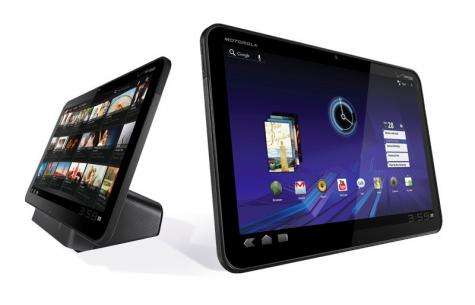Motorola Xoom an impressive tablet, but no iPad

Motorola's Xoom is the best non-iPad tablet so far. But it helps illustrate just how far ahead of its rivals Apple remains.
Before I get into that, let me say that there's a lot to like about the Xoom, which hit store shelves late last month. It's one of the first of the new tablets to sport a screen as large as that of the iPad, but the Xoom's screen is higher-resolution than the iPad's and is shaped like a high-definition television, making it ideal for displaying HD video.
The Xoom - from Motorola Mobility, the consumer electronics division that split off from Motorola in January - is the first tablet to run the new Honeycomb flavor of Google's Android operating system, which is specifically geared for tablets. Other tablets on the market run earlier versions of Android or operating systems designed for PCs.
The Xoom's software includes some other nice touches. Many of its built-in apps, such as its e-mail program and e-reader, have been designed to take advantage of its big screen. In the e-reader app, you'll see two pages at a time, and in the e-mail program, you'll see both the list of message in your inbox and the text of one message in particular.
Honeycomb also includes a notification feature at the bottom of the screen that allows users to see the subject of incoming messages, adjust settings or read alerts about such things as battery life without leaving or blocking the application they're running. It's a nice addition because it's functional and unobtrusive at the same time.
Like other flavors of Android, Honeycomb allows users to place small programs called widgets and other objects on one of five home screens. But on the Xoom, similar objects are grouped together. So you can place on the home screen a group of your bookmarked Web pages or your collection of e-books. To call up a particular Web page or e-book, you can flip through the stack of them on your home screen and tap on the one you want.
A neat new feature in the Android marketplace allows Xoom users to buy and update apps through a computer Web browser and send them over the air to the tablet and any other Android device they own. That's a much slicker way of updating your devices with the latest apps than Apple's method, which requires users to physically connect their devices to their computers and sync them to iTunes.
Like the iPad 2, the Xoom includes front- and rear-facing cameras that can be used to take pictures and videos and make video calls. And it has a battery that Motorola says will last up to 10 hours. I didn't precisely test that, but I had no complaints; in my tests, the Xoom endured several days of off-and-on use on a single charge.
Despite all this, the Xoom is still a work in progress.
Unlike the new iPad 2, the Xoom is supposed to be compatible with Verizon's new, high-speed LTE network. But it's not right now. Motorola promises to eventually upgrade the device for free to make it compatible, but even when the upgrade is available, users will have to ship their tablets to Motorola to get it. The company won't yet say how long customers can expect to be without their Xooms during the upgrade.
Another advantage of Android tablets over the iPad is that they're supposed to support Adobe's Flash software. But the Xoom didn't at launch, meaning it was no more able to pull up Flash videos or surf Flash-enabled websites than the iPad. Motorola does promise that it will make Flash available through a free download later this month.
Similarly, unlike the iPad, the Xoom has a slot into which users can insert a microSD card to give it more storage space. But the slot doesn't work right now, and Motorola hasn't said when it will provide users with the software to make it functional.
And there are other issues. There are very few apps that have been designed to work with Honeycomb because Google just released it. Many Android apps will work under Honeycomb, but many don't work well on it. The Twitter app, for instance, looks stretched out on the Xoom's big screen. And in the Pandora app, the album art disappears if you rotate the Xoom so that it's in portrait mode.
I also found the Xoom to be surprisingly sluggish. Like the new iPad 2, the Xoom sports a dual-core processor, which should make it super speedy. But I found a noticeable lag in doing everyday things, such as rotating its screen orientation from landscape to portrait, switching between apps and even loading Web pages.
And the Xoom faces other shortcomings, especially compared with the iPad. It's about $70 more expensive than Apple's comparable device. And unlike Apple, Motorola isn't offering lower-priced Xooms that have less storage space or don't include a cellular antenna. Furthermore, while Apple is now offering both AT&T and Verizon versions of the iPad, Motorola is offering only a Xoom that works with Verizon's network.
I have no doubt that Motorola and Google will address many of these issues over time. And even in spite of them, the Xoom is a very nice device.
But it's no iPad.
More information: Troy Wolverton is a technology columnist for the San Jose Mercury News.
(c) 2011, San Jose Mercury News (San Jose, Calif.).
Distributed by McClatchy-Tribune Information Services.




















